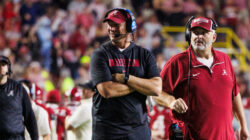
Some of the nation’s most feared rushing attacks were found in the SEC last season. Missouri was a far cry from one of those.
The Tigers totaled 1,385 rushing yards in 2015, better than just eight Football Bowl Subdivision teams. Their five rushing touchdowns were one better than Central Florida, which was last nationally in the category.
Will there be a massive improvement under first-year coach Barry Odom? Barring a significant surprise, the Tigers likely won’t resemble the LSU and Alabama rushing attacks from 2015. Still, there’s a chance Missouri will develop a pulse in the area after averaging an anemic 115.4 rushing yards per game last season.
The chance of the Tigers developing an offensive rhythm will depend, in part, on the running game becoming more effective this year. A more competent ground attack is needed as soon as possible to improve upon a letdown 5-7 season in 2015.
Rushing yards per game (SEC rank): 115.4 (last)
TDs: 5 (last)
ROTATION
Ish Witter should be the favorite to be Missouri’s feature back to begin the fall. That’s not necessarily a good thing. The rising junior had just 518 yards and one touchdown on 126 carries last season, meaning either the 5-foot-10, 190-pounder must improve in a big way for the Tigers to show life on the ground or someone else must break out.
Reports on Witter’s spring progress were encouraging, but it remains to be seen if the momentum will continue when Missouri kicks off for real at West Virginia on Sept. 3.

Overall, the depth remains a question. Shaun Conway, Trevon Walters, Ryan Williams and Damarea Crockett are possibilities for the rotation, but they’re unproven. Oklahoma graduate transfer Alex Ross should receive a close look after reportedly choosing Missouri, but he never had more than 88 carries in three seasons with the Sooners.
“We understand we’re young there,” running backs coach Cornell Ford told the St. Louis Post-Dispatch, “but it’s our job to get them ready.”
The Tigers’ outlook received a blow with highly regarded junior-college talent Nate Strong unavailable until January 2017 at the earliest because of academic issues. In addition, Marquise Doherty reportedly plans to leave the football program and focus on baseball elsewhere. There’s not much here that inspires confidence.
CHASING 1,000
Missouri has had a strong recent history of 1,000-yard rushers, with seven in the past decade. However, last season broke a streak of four consecutive years in which a Tigers running back reached the 1,000-yard mark.
Here are the Missouri running backs who have reached that milestone since 2006:
2006: Tony Temple, 1,063 yards
2007: Temple, 1,039 yards
2008: Derrick Washington, 1,036 yards
2009-10: None
2011: Henry Josey, 1,168 yards
2012: Kendial Lawrence, 1,025 yards
2013: Josey, 1,166 yards
2014: Russell Hansbrough, 1,084 yards
2015: None
Unless something unexpected happens, it’s hard to see Missouri producing another 1,000-yard rusher this season. If Witter is the featured back, he must make a significant leap from his underwhelming production in 2015. Ross, meanwhile, never ran for more than 595 yards in a season during his time at Oklahoma.

The Tigers will enjoy a pleasant surprise if someone approaches 1,000 yards.
PLAY-CALLING
As we mentioned in the passing game breakdown, it would be wise to approach trends from last season with caution given all the offseason changes that have taken place. But Missouri ran 193 times for 555 yards on first down, according to cfbstats.com. In addition, the Tigers ran 122 times for 548 yards on second down and 73 times for 228 yards on third down. In short-yardage third-down situations – 3rd-and-3 or fewer – they ran 25 times for 71 yards.
All this highlights the work Missouri must do to make its running game competitive again. To think, the Tigers’ ground attack used to be one of the most feared aspects of their offense. After all, we’re not far removed from when Henry Josey ripped defenses for 1,166 yards in 2013 or when he had 1,168 in 2011 – the most by a Missouri running back in the past decade.
It will be interesting to see how run-heavy the Tigers become in their first season with offensive coordinator Josh Heupel, who’s surely eager to shake things up in Columbia. Missouri’s offense was painful to watch at times last season, and a toothless ground game contributed to the mess.
GREATEST CONCERN
The lack of depth is glaring. It’s fair to be skeptical about Witter entering the season. Ross and Crockett might turn out to be fine additions, but they must prove it on the field in a hurry.
IT'S OFFICIAL! @DamareaCrockett is going to be #MizzouMade! Welcome to the #MizFam! pic.twitter.com/rEE2nILBpM
— Nick Otterbacher (@Coach_Otter) February 3, 2016
There doesn’t appear to be a dynamic option ready to scare defenses from the start, unless someone surprises in fall camp. Clearly, an effective running game would make quarterback Drew Lock’s job easier. Still, there are many questions about this group’s ability to make defenses respect the Tigers’ ground threat. It’s hard to imagine Missouri’s running game performing worse than it did last year, but there are few certainties at the moment.
ONE STAT THAT MUST IMPROVE
More yards, more yards, more yards. Seems simple enough, right? But a more effective rushing attack would place less pressure on Lock and his group of unproven targets as they acclimate themselves with a new coordinator. Since the 2009 season began, only two SEC teams have finished with a worse rushing total than the one Missouri posted last year: Tennessee with 1,081 yards in 2011 and Vanderbilt with 1,311 in 2014.
Part of the problem was the lack of a home run threat. Missouri had just two runs longer than 30 yards last season, and Lock provided one of those. Again, only UCF had fewer.
It’s fair to say the running game should be a point of emphasis for Odom and his staff this season. Perhaps Heupel’s scheme will discover a diamond in the rough, but that could be asking too much.
BETTER OR WORSE IN 2016
We’ll give the benefit of the doubt to Heupel and predict that his presence makes Missouri’s ground game better. Witter should be a more mature runner. Plus, there’s the potential for Ross and/or Crockett to surprise. Perhaps an unknown will assert himself and make the new staff pay attention.

But however you look at the Tigers’ situation, there are more “ifs” and “maybes” than guarantees now. Still, they won’t need to do much to improve upon a dreadful 2015 campaign on the ground. It’s unlikely that Missouri will finish as one of the most feared SEC rushing attacks, but there should be improvement.







